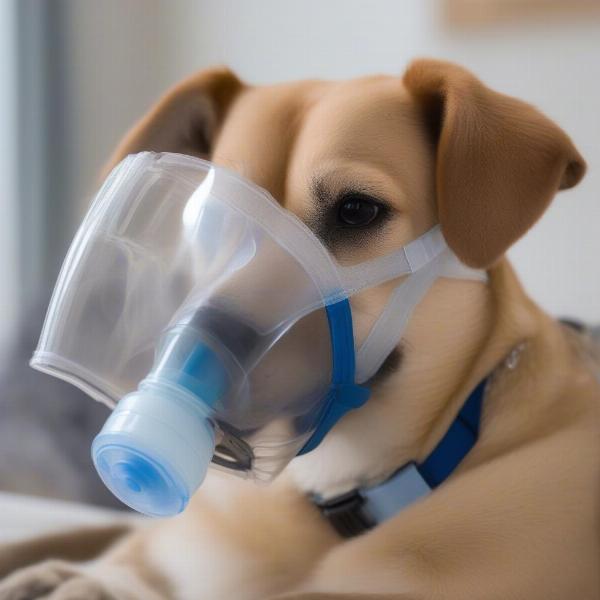A dog nebulizer machine, often referred to as a respiratory therapy device, is a valuable tool for administering medication directly to your dog’s lungs. It transforms liquid medication into a fine mist that your dog inhales, providing targeted treatment for respiratory conditions like asthma, bronchitis, and kennel cough. This article provides a comprehensive guide to understanding dog nebulizer machines, covering everything from how they work to choosing the right one for your furry friend.
How Does a Dog Nebulizer Machine Work?
The core function of a dog nebulizer machine is to convert liquid medication into an easily inhalable aerosol. This process allows the medication to bypass the digestive system and reach the lungs directly, offering faster relief and minimizing potential side effects. The machine consists of a compressor, a medication cup, and a mask or mouthpiece. The compressor pumps air into the medication cup, transforming the liquid medicine into a fine mist. This mist is then delivered to your dog through the mask or mouthpiece, allowing them to breathe in the medicated air.
Choosing the Right Dog Nebulizer Machine
Selecting the appropriate nebulizer for your dog can significantly impact the effectiveness of the treatment. Factors to consider include your dog’s size and temperament, the type of medication prescribed, and the severity of their condition. For smaller dogs or those with anxiety, a quieter machine with a comfortable mask is essential. For more severe respiratory issues, a nebulizer capable of delivering higher medication doses might be necessary.
Types of Dog Nebulizer Machines
There are several types of nebulizers available, each with its own advantages and disadvantages.
- Compressor Nebulizers: These are the most common and affordable type, suitable for most dogs. They are generally durable and easy to use.
- Ultrasonic Nebulizers: These use high-frequency sound waves to create a finer mist, potentially delivering medication deeper into the lungs. They are quieter than compressor nebulizers, which can be beneficial for anxious dogs.
- Mesh Nebulizers: These are the newest type of nebulizer, utilizing a vibrating mesh to create the aerosol. They are portable, silent, and highly efficient.
Using a Dog Nebulizer Machine: Step-by-Step Guide
Using a dog nebulizer machine effectively requires following a few key steps:
- Consult your veterinarian: Always seek professional advice before starting nebulizer treatments for your dog. They will determine the appropriate medication and dosage.
- Prepare the nebulizer: Fill the medication cup with the prescribed medication, ensuring it’s at room temperature. Connect the tubing and mask or mouthpiece.
- Acclimate your dog: Introduce the nebulizer gradually, allowing your dog to sniff and become comfortable with it. Positive reinforcement with treats can be helpful.
- Administer the treatment: Gently place the mask over your dog’s nose and mouth, ensuring a secure but comfortable fit. Turn on the machine and allow your dog to inhale the mist for the prescribed duration.
- Clean the nebulizer: After each use, thoroughly clean and disinfect the nebulizer components according to the manufacturer’s instructions.
Tips for Successful Nebulizer Treatments
- Create a calm and relaxing environment for your dog during treatments.
- Use positive reinforcement and rewards to create a positive association with the nebulizer.
- Monitor your dog closely for any signs of distress or discomfort.
- Follow your veterinarian’s instructions carefully regarding medication dosage and treatment frequency.
 Dog Using Nebulizer Mask
Dog Using Nebulizer Mask
Conclusion
A dog nebulizer machine can be an invaluable tool for managing respiratory conditions in dogs. By understanding how they work, choosing the right type, and using them correctly, you can ensure effective treatment and improved respiratory health for your canine companion. Remember to always consult with your veterinarian for guidance on using a dog nebulizer machine and follow their instructions carefully.
FAQ
- How long does a nebulizer treatment typically last? Treatment times vary depending on the prescribed medication and your dog’s condition, but typically range from 5 to 20 minutes.
- Can I use a human nebulizer for my dog? It’s best to use a nebulizer specifically designed for dogs, as the mask size and medication delivery may differ.
- What are the side effects of nebulizer treatments? Side effects are rare, but may include coughing, sneezing, or slight nasal discharge.
- How often should I clean my dog’s nebulizer? Cleaning after each use is recommended to prevent bacterial growth and ensure optimal performance.
- Where can I purchase a dog nebulizer machine? Dog nebulizers can be purchased from veterinary clinics, pet supply stores, and online retailers.
- Are there any alternative treatments to nebulization for respiratory issues in dogs? Alternative treatments may include oral medications, inhalers, or oxygen therapy, depending on the specific condition.
- How do I know if my dog is benefiting from nebulizer treatments? Improvements in breathing, reduced coughing, and increased activity levels are signs that the treatment is effective.
ILM Dog is a dedicated resource for dog owners worldwide, offering expert advice on all aspects of canine care, from breed selection and health to training and nutrition. We provide practical, reliable information to help you provide the best possible care for your furry friend. For personalized guidance on dog health, including respiratory care, contact our experts at [email protected] or call us at +44 20-3965-8624. Visit ILM Dog for more valuable resources and information.